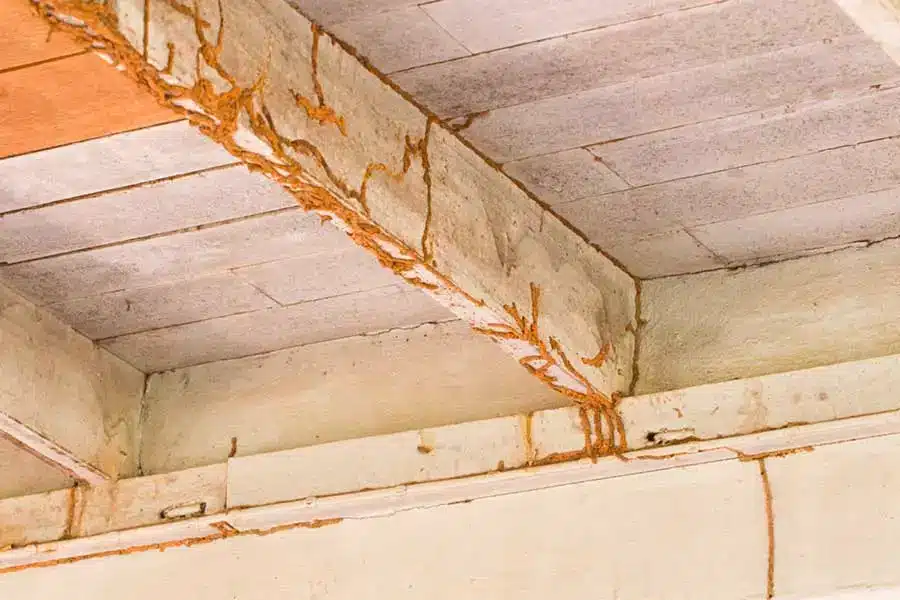Last Updated on October 28, 2025 by Arizona Termite Control
You notice a few mud tubes creeping up your foundation or tiny wings scattered across the floor, and your stomach drops. Termites. Not the kind of surprise anyone wants. But before you panic, take a breath—there are ways to handle minor termite problems yourself if you catch them early enough. Arizona’s warm climate makes it a hotspot for termite activity, especially in Maricopa County, so learning how to handle these invaders isn’t just handy—it’s almost a homeowner requirement.
Contents
- 1 Step One: Identify What You’re Dealing With
- 2 Step Two: Gear Up With the Right Tools and Products
- 3 Step Three: Create a Trench Barrier (Subterranean Termites)
- 4 Step Four: Foam or Dust Wall Voids (Drywood Termites)
- 5 Step Five: Set Up Bait Systems
- 6 Step Six: Treat Wood Surfaces for Prevention
- 7 Step Seven: Keep Conditions Termite-Unfriendly
- 8 When DIY Isn’t Enough
- 9 Peace of Mind Starts with a Plan
Step One: Identify What You’re Dealing With
Not all termites act the same, and how you treat them depends on which type has moved in.
Subterranean termites are the most common in Arizona. They live underground and build mud tubes to reach wood. You’ll usually see their tunnels around your foundation or on concrete walls.
Drywood termites, on the other hand, live inside the wood—no soil contact needed. You’ll often find their droppings (tiny wood-colored pellets called frass) near windows, door frames, or attic beams.
If you’re seeing soft, hollow wood, wing piles, or mud tubes, it’s likely subterranean. If your walls or furniture are producing little mounds of pellets, it’s probably drywood. Knowing which you’re dealing with helps you pick the right treatment product.
Step Two: Gear Up With the Right Tools and Products
Before you start any DIY termite control project, gather your gear. You’ll want gloves, goggles, a sprayer, a small garden shovel, and, of course, the right termite killer.
Here are some proven DIY options you can order online:
- Termidor Foam (available at DoMyOwn.com): Ideal for drywood termites and wall voids. It expands deep into cracks and kills by contact.
- Taurus SC (sold on Amazon): Works similarly to Termidor but as a liquid barrier. Perfect for trenching around the foundation.
- Spectracide Terminate Bait Stakes (Home Depot): Good for perimeter monitoring and light infestations.
- Bora-Care Wood Treatment (Nisus Corp): A natural borate-based solution that penetrates wood and prevents future infestations.
Each of these products targets a specific type of termite behavior—some for prevention, others for active colonies.
Step Three: Create a Trench Barrier (Subterranean Termites)
If you’ve got subterranean termites, your main goal is to treat the soil where they’re nesting. Here’s how:
- Dig a trench around your home’s foundation—about 6 inches wide and 6 inches deep.
- Mix your termiticide (like Taurus SC or Termidor SC) according to the label instructions.
- Pour the solution into the trench, saturating the soil evenly.
- Backfill the trench with treated soil to seal the barrier.
This creates an invisible defense wall that termites can’t detect. When they pass through, they unknowingly carry the active ingredient back to the colony, spreading it until the queen dies off.
Pro tip: focus on shaded or damp areas near sprinkler lines or downspouts—those are high-traffic zones for termite tunnels.
Step Four: Foam or Dust Wall Voids (Drywood Termites)
If termites are nesting inside your walls or attic beams, direct injection works best. Use Termidor Foam or a dust applicator to reach deep into infested wood or cracks.
- Drill small holes about every 10 inches along the damaged area.
- Insert the foam applicator nozzle and fill each cavity until it expands slightly.
- Wait a few hours for it to dissipate and kill hidden colonies.
- Seal the holes with wood filler or caulk.
The foam treatment works fast and leaves behind a residue that keeps killing termites for weeks.
Step Five: Set Up Bait Systems
Bait systems are perfect for long-term protection. Think of them as termite tripwires—they attract termites, deliver a slow-acting poison, and spread it throughout the colony.
Here’s how to do it:
- Place Spectracide Terminate Stakes around your home’s perimeter about every 10 feet.
- Focus on shady, moist areas where termites are more active.
- Check the stakes every month. If you see mud tubes or eaten bait, replace them immediately.
This step is crucial for keeping reinfestations at bay, especially in Arizona’s year-round termite climate.
Step Six: Treat Wood Surfaces for Prevention
Once you’ve controlled active infestations, it’s time to protect your home for the long haul. Treat all exposed wood—especially in attics, sheds, and garages—with a borate solution like Bora-Care.
You can apply it with a simple sprayer or paintbrush. As the borate soaks in, it crystallizes inside the wood fibers, making it impossible for termites to digest. It’s odorless, long-lasting, and safe around pets once dry.
Step Seven: Keep Conditions Termite-Unfriendly
Even the best DIY treatment won’t last forever if your property still attracts termites. Here’s how to make your home less appealing:
- Fix leaky faucets, irrigation lines, or AC condensation drains.
- Store firewood at least 20 feet from the house.
- Keep soil and mulch at least six inches below your siding.
- Seal foundation cracks and caulk around plumbing or utility lines.
Think of it as termite-proof landscaping—less moisture, less wood-to-soil contact, fewer surprises later.
When DIY Isn’t Enough
Let’s be honest. DIY treatments can save money and stop small infestations, but if you’ve got termites in your walls, floors, or crawlspace, it’s time to call in the experts. Arizona’s subterranean colonies can stretch 300,000 strong—and once they’re deep under your foundation, professional tools are the only way to end it.
A licensed termite technician can combine soil treatments, bait systems, and moisture control for total protection. They’ll also know where to look for secondary colonies you might miss.
Peace of Mind Starts with a Plan
DIY termite control can go a long way, but prevention is everything. Stay consistent, monitor regularly, and don’t ignore small warning signs.
And if you’re ready to take the next step toward full protection—especially if you’ve already seen termite activity—it’s time for a professional inspection. Protect your home, your equity, and your peace of mind.
By Phone: Call 480-660-3093
By Form: Request a Free Termite Inspection




